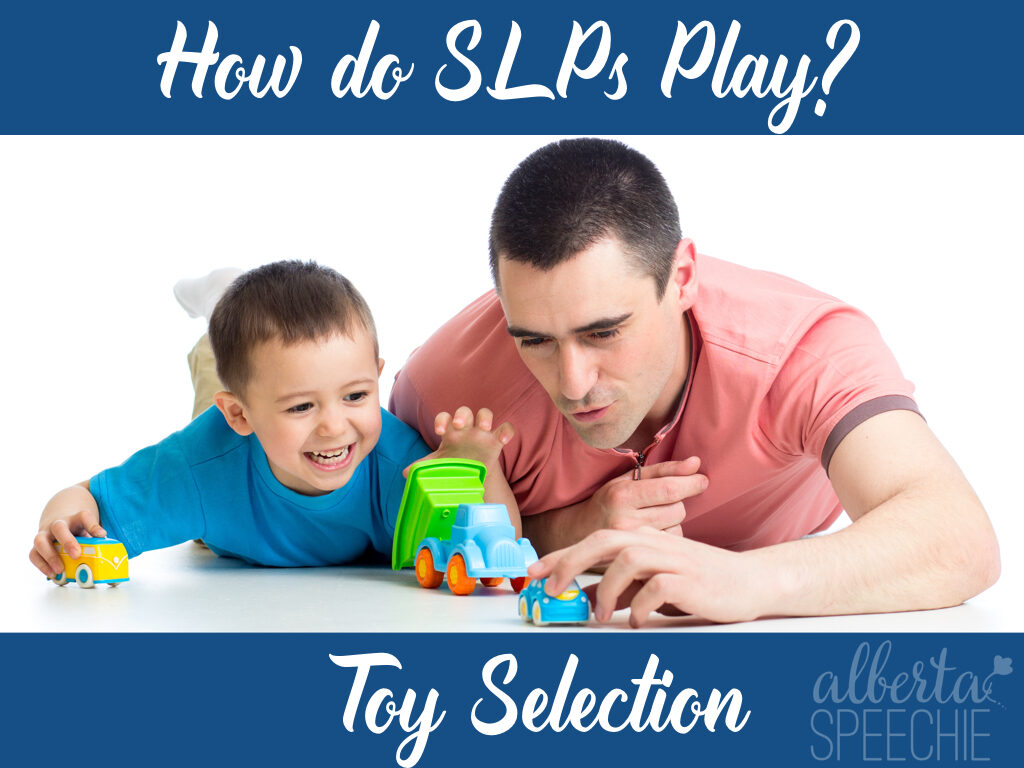Last week, I talked about “Why SLPs play?” This week I’m going to describe a little about how SLPs play, specifically how do we choose what toys/materials to use. I work with preschoolers so this post will have a bit of focus on younger children but the same principles apply to older children as well.
It may seem that the SLP comes in and they start to play. It usually looks easy. SLPs don’t just pick any old toy and then magic suddenly happens. There are many variables to consider when picking toys to use in therapy.
It may seem that the SLP comes in and they start to play. It usually looks easy. SLPs don’t just pick any old toy and then magic suddenly happens. There are many variables to consider when picking toys to use in therapy.
1. Where developmentally is the child? An SLP is not going to expect a child to play with boardgames, if the child is developmentally at the stage for people games such as “peek a boo.” The same goes that they are not going to play “peek a boo” when the child could play boardgames.
2. Where developmentally is their play? Does the child like to play by themselves? Will the child allow people to play beside them but not yet ready to play with others? Do they play with others? Do they have pretend play skills? This will help the SLP to narrow down appropriate choices in toys.
3. What are their goals? The types of goals the child is working on can really determine the kinds of toys an SLP will bring into the therapy room. They might bring in barns and farm animals if the child is working on prepositions. They may bring in wind up toys if a child is working on requesting objects.
4. What are the child’s favourite toys? Part of therapy is that it should be fun. SLPs consider what kinds of toys the child likes to play with. Sometimes they will use their favourite toys and other times they may intentionally choose different toys.
5. What is the child’s attention span? Can a child focus on an activity for 10 minutes or more? Can the child only focus on an activity for a minute or more. This will determine how many toys to bring to therapy and helps determine the kinds of possible toys available. If a child has a short attention span, then a toy that takes time to set up would not be appropriate.
6. What are the themes at school or occur naturally at different times of the year? Does the child go to school? What are they learning about? What is a natural theme that would occur at the time of the year? If it is October, then talking about fall or Halloween would be appropriate. This allows the SLP to use vocabulary that the child will hear in other context and this helps the child in other settings and with generalization.
7. What are the philosophies of the parents/school? Some people might no think about it but this is an important piece of the decision making process. I used to work at a more fundamentalist Christian school. Bringing in toys about ghosts or Halloween would not have been appropriate. Incorporating yoga into my sessions would also not have been appropriate. Working at a school that has a more artistic focus might mean that the children there do more crafts.
8. Does the SLP travel? If an SLP is moving from location to location then that can determine the types of materials (aka toys) they can carry/transport.
9. Is it going to be one-on-one therapy or a group session? If it is a group, then you have to think about all of the above criteria for each child then come up with common toys to use with the group.
These are just some of the decisions SLPs make multiple times a day when choosing appropriate materials to use in therapy.
8. Does the SLP travel? If an SLP is moving from location to location then that can determine the types of materials (aka toys) they can carry/transport.
9. Is it going to be one-on-one therapy or a group session? If it is a group, then you have to think about all of the above criteria for each child then come up with common toys to use with the group.
These are just some of the decisions SLPs make multiple times a day when choosing appropriate materials to use in therapy.

